|
Quinta
de Sant'Ana
Visiting this upcoming producer from the Lisboa region in Portugal
Website: www.quintadesantana.com
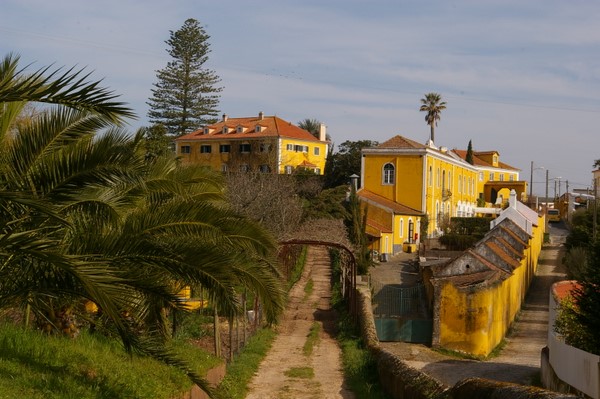
Quinta
de Sant’Ana (above) is the family property of James and Ann
Frost. James (below right) is English; Ann is German, and the
property was previously owned by her parents,  Gustav
and Paula von Fürstenberg. The Quinta is located in what was until
recently known as the Estremadura region of Portugal, but is now
referred to as Lisboa, some 35 km north of the capital, and 12 km
inland from the Atlantic. As a consequence, the weather patterns are
strongly influenced by the sea, and this is quite a cool spot in
comparison with say, for example, the Alentejo. This is a relatively
unfashionable area, largely because in the past wine production here
valued quantity over quality, but Sant’Ana are one of a small band
of producers who are showing that high quality wines are possible
here. Gustav
and Paula von Fürstenberg. The Quinta is located in what was until
recently known as the Estremadura region of Portugal, but is now
referred to as Lisboa, some 35 km north of the capital, and 12 km
inland from the Atlantic. As a consequence, the weather patterns are
strongly influenced by the sea, and this is quite a cool spot in
comparison with say, for example, the Alentejo. This is a relatively
unfashionable area, largely because in the past wine production here
valued quantity over quality, but Sant’Ana are one of a small band
of producers who are showing that high quality wines are possible
here.
Wine
is a recent development for Quinta de Sant’Ana. Although Ann’s
parents did plant some vines, it is only since 1999 that the project
really began, when James sought the advice of viticulturalist David
Booth and his enologist colleague António Maçanita (below),
and began planting vines. The first wines were made in 2004, but
this wasn’t an ‘official’ release. The first commercial
release followed a year later, and planting of the vineyards has
continued to the point where there are just a couple of hectares
that could still be planted if needed. Hospitality has been a big
part of the business of the quinta: this is a very popular location
for weddings, and the revenue for this has funded the development of
the wine side of the estate in a sustainable fashion, to the point
that wine is now the main enterprise.
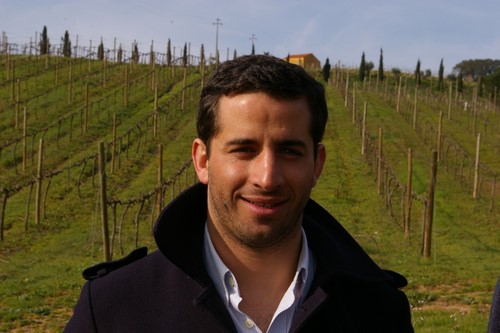
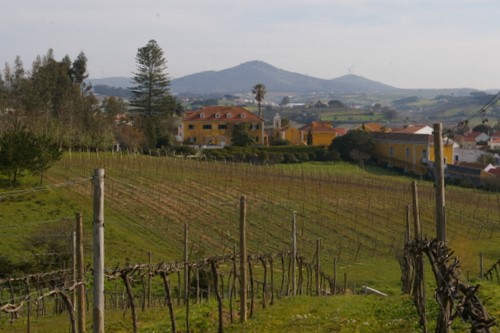
There
are now 11.5 hectares of vineyards, with woodland, orchard and
paddocks making up the balance of the 44 hectare estate. Grape
varieties planted are Touriga Nacional, Merlot (1.2 Ha), Pinot Noir
(2 Ha, recently planted) and Aragonêz for reds, and Fernão Pires,
Alvarinho, Riesling (0.5 Ha, recently planted), Verdelho and
Sauvignon (0.4 Ha) for whites.
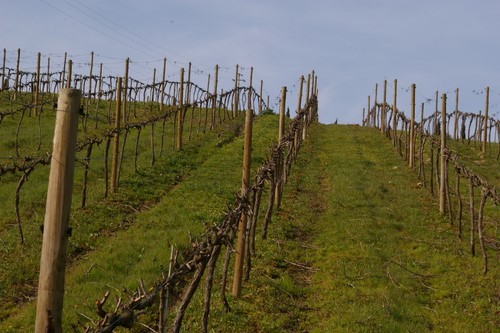
The
soils here are quite deep, and vigour can be a problem for the
vines. For this reason, James and António have been working hard to
keep the canopies under control. The vines are planted on carefully
selected devigorating rootsocks (3309 and Riparia), and backhoe pits
were dug to assess the potential vigour of different parts of the
vineyard, before canopy height was decided.
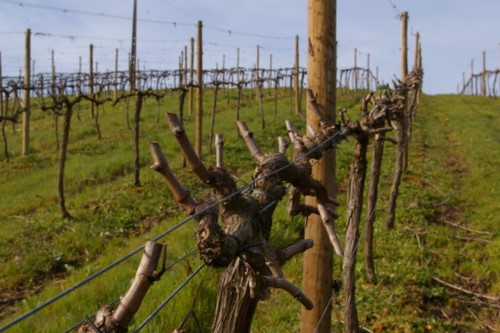
Much
of the vineyard is managed using split canopies (the vines are
trained higher, and a canopy growing down is added to the one
growing up: this is a way of dealing with high vigour sites). For
example, if there is 70 cm of usable soil, the vines will typically
be trained at 70 cm and the canopy will be 2 m high, giving a 1.3 m
canopy height. In some of the older blocks the vine posts have been
extended to give higher canopies. A typical calculation is that one
kilo of grapes needs a canopy area of 2 m2 to ripen where high
quality is sought.
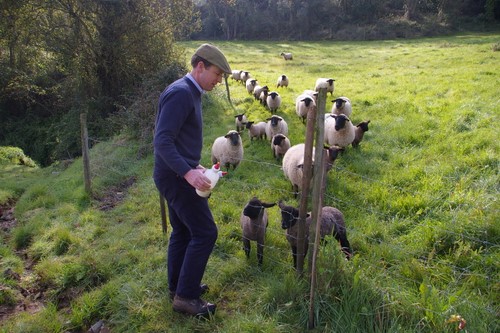
Few
fertilizers are used: the idea is to get the canopy to stop growing
naturally at the ideal height. For some patches, canopy growth may
be a little too weak: then soil tests are carried out. In one spot
last year a block of Touriga was struggling, and tests showed that
while the iron was present in the soil, the pH was too high, so the
iron wasn’t available to the vine. The solution is to modify the
soil pH of this particular block.
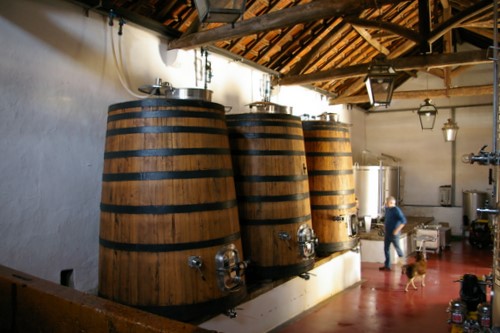
The
winery is simple but effective. There are two lagares of 4.5 hl
each; wooden vats with stainless steel inside (4 hl) and three
stainless steel tanks of 2.5 hl. Whites are pressed and then racked
the day after; they obtain clean juice without using bentonite or
PVPP fining. Fernão Pires can tend to be terpenic, almost like
Muscat, so António allows only a short skin maceration and ferments
cool (12 °C) to suppress this terpenic character. This year three
different pickings of the Fernão Pires took place: the upper part
of the vineyard, which is really more like a red block in climate,
gives richness; the acidity comes from the middle part. Before 2009
some barrel fermentation was used, but from this vintage none is
practised for any of the whites.
Sauvignon
Blanc is fermented a little warmer (14–16 °C) to allow the
variety to express itself a little more. (Loire Sauvignon would be
fermented typically at 18–20 °C.)
THE
WINES
Quinta
de Sant'Ana Alvarinho 2009
Whole-bunch-pressed, settled for a day, and fermented at 14 °C.
Some yeast nutrients added, and inoculated with a yeast isolated
from Vinho Verde. Very taut, fresh and lemony, but with some
texture, too. Crisp and taut with lovely fruit. This could just do
with a touch more aromatic interest, and this may come with time in
bottle. 89/100
Quinta
de Sant'Ana Verdelho 2009
Fresh, bright, lemony and herby with lovely crispness to the
fruit. Lemony and bright with good concentration and some gentle
grassy notes. Lovely purity; a satisfying wine. 88/100
Quinta
de Sant'Ana Riesling 2009
Very nice aromatics here: citrussy, lemony. The palate is lively
and fresh with lemon, herb, pear and grapefruit notes. Lovely purity
and focus to this wine, which is tight but shows lovely fruit.
Pithy, citrussy finish. 90/100
Quinta
de Sant'Ana Sauvignon Blanc 2008
Dense and fruity with nice presence and a touch of tomato leaf
herbiness. Nice depth
here: it’s not overblown and has some grapefruit freshness. A
stylish Sauvignon showing some restraint. 88/100
Quinta
de Sant'Ana Sauvignon Blanc 2009
Fresh and taut with some crisp green herby (methoxypyrazine)
notes. Grapefruit, grass and herb characters merge well, with good
acidity and some lemony notes on the finish. Very stylish with some
mineral notes on the finish: a serious Sauvignon. 90/100
Quinta
de Sant'Ana Fernão Pires 2008
Very expressive and lively with some nice grapey richness as
well as peach and pear notes, but there’s restraint, too. An
expressive white wine with lots of personality, and great balance
between the rich fruitiness and the fresh grapefruit notes.
There’s a subtle nutty hint. 90/100
Quinta
de Sant'Ana Fernão Pires 2009
Beautiful aromas of melon and herbs with floral overtones.
Lovely fresh grapefruit and herb palate with a hint of richness. The
dominating theme, however, is the fresh, crisp, intense fruit with
some nice mineral overtones. 91/100
Quinta
de Sant'Ana Rosé 2009
Very richly fruited with cherry and berry fruits and some
sweetness countered by fresh acidity. A rich style with a creamy
texture: a smart commercial wine. 87/100
Quinta
de Sant'Ana Pinot Noir 2009 (tank sample)
Lovely lifted aromas with sweet, pure, rounded cherry and berry
fruit. Tastes like Pinot Noir with a hint of meatiness and some
spice underneath the fresh, complex fruit. There’s a nice hint of
spicy stemminess (30% whole bunches used), and it’s a complex,
elegant wine with a degree of seriousness to it. Superb for a first
effort. 91–93/100
Quinta
de Sant'Ana Tinto 2007
A blend of 60% Touriga Nacional with 40% Aragonêz. Very fresh,
focused spicy, chocolatey, meaty nose with vibrant blackberry fruit.
The palate is dense and spicy with robust dark fruits and attractive
spice notes. Fresh and vibrant. 89/100
Quinta
de Sant'Ana Tinto 2008
Mostly Touriga, with 17% Merlot and 5% Aragonêz. Fresh,
vibrant, juicy and plummy with nice density of pure berry fruits,
backed up by some spiciness. Lovely purity of fruit here: focused,
with plum and cherry notes. Finer and more elegant than the 2007.
90/100
Quinta
de Sant'Ana Reserva 2006
Spicy, meaty, fresh dark fruits nose. The palate is focused and
fresh but with a meaty, spicy undercurrent. Hints of earth and
minerals. It finishes with some bretty character, but there’s nice
freshness here. 90/100
Quinta
de Sant'Ana Reserva 2005
Lovely freshness and ripeness here. A generous but balanced
rich, dense wine with lovely precision to the fruit. Fresh and pure
with nice tannins. Just beautiful. 93/100
Quinta
de Sant'Ana Homenagem a Baron Gustav von Fürstenberg 2007
Fresh and bright with a green leafy edge to the nose, and a bit of
chalkiness. Pure, quite elegant palate with some cherry, plum and
blackcurrant notes. Stylish, pure and elegant with the Merlot (50%)
making its presence felt. 92/100
Quinta
de Sant'Ana Reserva 2008
(Almost all Aragonêz.) Bottled a week ago, so still a bit
shocked. Lovely freshness here: this is bright with nice cherry and
berry fruit and good acidity. Nice focus and purity to this.
92–94/100
See
also:
 Articles
and tasting notes on Portuguese wines Articles
and tasting notes on Portuguese wines
Wines
tasted as 03/10
Find these wines with wine-searcher.com
Back
to top
|

